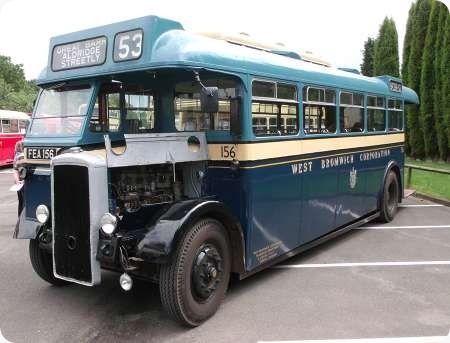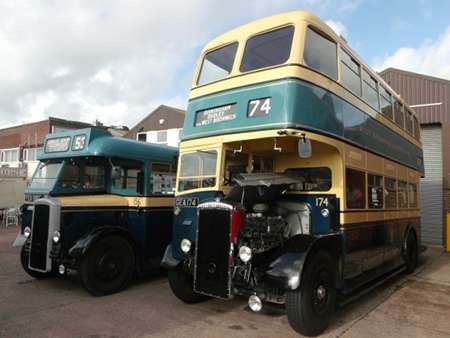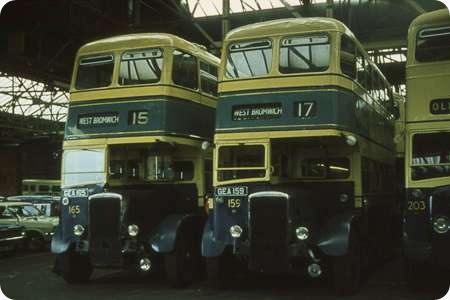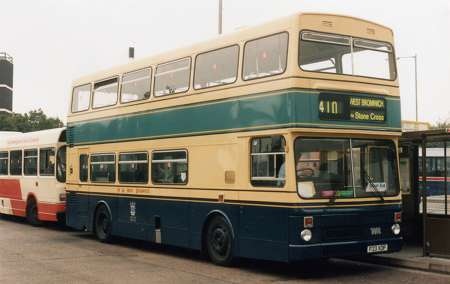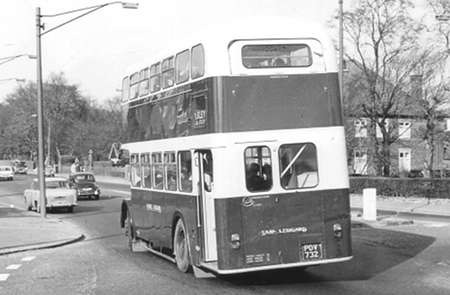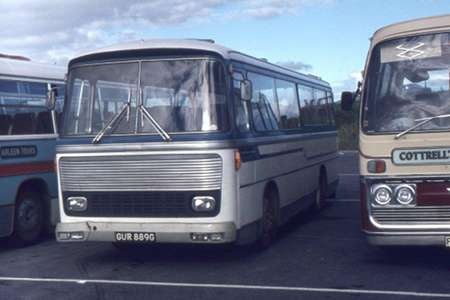Birmingham City – Daimler Fleetline – BON 541C – 3541
Birmingham City Transport
1965
Daimler Fleetline CRG6LX
MCCW H39/33F
BON 541C is a Daimler Fleetline CRG6 with Metropolitan Cammell body, new to Birmingham City Transport in 1965, with fleet number 3541. On the formation of West Midlands PTE, all she had was a change of lettering in what some of the neighbouring authorities considered to be a take-over by Birmingham. We see her at Elmdon Airport on 23 July 1977, ready to return to High Street on the 58. I liked the use of the third blind, showing TO CITY or FROM CITY, but I know not everyone did.
Photograph and Copy contributed by Pete Davies
22/08/13 – 17:44
Needs a picture like this to remind me I came to Birmingham in 1970 to Aston University and travelled on buses like this every day from my digs in the suburbs. I also like the to/from city when used, it helped give directions to fellow students. Forty years this year since I graduated and that’s 4 years before this picture was taken – thanks for bringing back my unversity memories. In 1977 I would be involved in the Queen’s Jubilee – more memories.
Ken Jones
23/08/13 – 06:20
Thanks for the comment, Ken. I was a student at Saltley mid to late 60’s. This view was captured during a lunch stop on my way up to the Lake District.
Pete Davies
23/08/13 – 15:36
Peter’s shot also reminded me of my days in Brum. In a previous life I worked (28 years) for Woolworth. From 1970 – 1972 I was Deputy Manager of the New Street branch. As I lived near Hagley Road I would use the 6 (Sandon Road), 7 (Portland Road) or 9 (Quinton). Whilst these were often served by the old Birmingham standards, evenings and weekends would be rear-engined buses. These were more comfortable than the 7’6" standards but lacked the character. Thanks for posting this shot Peter.
Les Dickinson
23/08/13 – 15:37
Interesting comment about the West Midlands PTE being a virtual Birmingham take-over particularly in terms of the livery. This applied to some extent with all the first four PTE’s with the exception of SELNEC. Liverpool green in various hues dominated on Merseyside after initially allowing Birkenhead’s blue to continue on the Wirral for a while and South Shields disappeared in a sea of Yellow on Tyneside. The livery here was virtually Newcastle Corporation with a new logo. Only in the north west did something completely different come out of the hat with SELNEC’s dazzling Sunglow Orange and White. You either loved it or hated it but you definitely could not ignore it.
Philip Halstead
23/08/13 – 17:48
Thanks for your comments, Les and Philip. One of my friends hails from Wolverhampton and becomes very cross when people comment on his "Brummy" accent. The polite bit of his reply – very apt for this site – includes "I’m not a Brummy. I’m a Wulfrunian!"
Pete Davies
23/08/13 – 17:49
To be fair to the MPTE the Liverpool livery only survived on that side of the Mersey while the Wirral had a composite of Birkenhead and Wallasey colours.
When a standard MPTE livery was finally imposed the Verona Green was a very different shade of green applied far more sparingly than the overall LCPTD green livery.
Rob McCaffery
23/08/13 – 19:11
The ‘To/From City’ display was because BCT did not change blinds at the outer terminus, so a bus on the 9 would still be showing Quinton, even when heading into the City! This was partly mitigated by each bus stop flag displaying To or From City as appropriate. The To/From blind was thus some sort of progress.
Tony Martin
24/08/13 – 11:51
The Birmingham policy on not changing destination blinds at outer termini is a strange one. How did it work on cross-city routes? Destination blinds can throw up some strange and interesting quirks. Hull for example for many years did not show an end destination at all, only a ‘via’ blind was shown under the route number for the main road served. Salford didn’t have the word ‘Salford’ on its blinds at all as all the inner city termini were either over the Irwell in Manchester or branded as ‘Victoria’ for their bus station by the old Manchester Exchange station. I once heard that a publicity photo was being taken for a new delivery of Salford buses and to show the city’s name in the destination space required the word to be pasted onto the negative by artwork. (Obviously it was well before the age of digital trickery!).
Philip Halstead
24/08/13 – 15:20
On BCT’s cross city routes, buses always showed the ultimate destination. The to/from city on bus stop flags was considered enough.
Tony Martin
25/08/13 – 06:35
Tony, am I right in thinking that at least some of the Cross City services had – for example – 15 Handsworth in one direction and 16 Selly Oak in the other?
What many folk must have found utterly confusing was the idea of setting the blind at SERVICE EXTRA but not showing a number. It seems to have died out – fortunately – when the last buses with service number and destination on one roll were withdrawn!
Pete Davies
25/08/13 – 08:50
‘Victoria’ was used on Salford’s blinds for intra urban routes. Longer distance routes from Bolton, Warrington etc showed ‘Manchester’ as the destination though they terminated in Salford albeit often at the dingy Greengate tunnel adjacent to Victoria bus station. I believe that ‘Salford’ only appeared in the destination boxes on the covers of such publications as timetables.
Manchester buses never showed ‘Manchester’ in the final destination box save for service 6 from Glossop which detailed ‘Manchester’ and in very small print, Lower Mosley Street (the only MCTD route to terminate there).
Orla Nutting
25/08/13 – 08:50
Many Tilling and BET companies had the policy of using a combination of the route number and "duplicate" with no destination shown. Useful no doubt for any inspector along the route but pointless for the intending passenger, especially in seaside and other holiday areas where heavy loadings in summer saw the practice in wide use.
Phil Blinkhorn
25/08/13 – 11:29
Orla, whilst you are 100% correct regarding the Salford blinds, Manchester Chorlton St appeared on the blinds of the half decker airport buses when the city terminus was moved there from Royal Exchange and a regular headway was introduced rather than the flight specific service that had operated previously. The destination was an addition to the existing blind. When in later years the service was numbered 200 and operated by Bedford VALs the same destination appeared . All airport services were operated by Parrs Wood depot.
All service buses running into Chorlton St showed "Manchester Chorlton St". The routes involved during the 1960s were 19 from Hattersley (Hyde Rd depot), 20/20X from Woodford/Poynton (Birchfields depot), 31 from Bramhall (Parrs Wood depot), 33 from Greave, 33X from Stockport Andrew Sq, 34 from Romiley (all Hyde Rd depot), 59 from Shaw (Queens Rd/Rochdale Rd depots), 74 from Stockport Vernon Park (Parrs Wood depot), 121 Langley (Queens Rd/Rochdale Rd), 124 from Haughton Green, 125 from Old Glossop, 126 Haughton Green (all Hyde Rd), 148X from Wythenshawe Civic Centre (Northenden depot), 152 from Sales Woodheys (Princess Rd depot), 160 from Denton Moorfield Estate (Hyde Rd depot), 207/208/209 all from Hattersley (Hyde Rd depot), 500 from Alderley, 503 from Adswood Greyhound (both Parrs Wood).
Admittedly photos showing blinds set to the destination are uncommon due in part to the restricted use of the facility before it was then encased by a multi-storey car park which almost precluded photography due to the stygian gloom. "The Manchester Bus" has a Burlingham bodied Tiger Cub half decker displaying the blind on page 232 and an Aberdonian on page 357. The Colours of Greater Manchester has a blue Tiger Cub showing the destination on page 18.
Phil Blinkhorn
As a rider to my previous post, all the routes for which the Manchester Chorlton St destination was shown, with the exception of the 148X, originated outside the city boundaries and this may have been the reason -though routes from outside to Piccadilly, Cannon St, Stevensons Sq, Albert Sq or Exchange never had the need to show Manchester.
Phil Blinkhorn
25/08/13 – 16:08
Manchester did eventually make good on the services to Saddleworth at least as I have pictures of PD2s showing Manchester Stevenson Square, but these are in late SELNEC and GMT days. There had no doubt been a need for new blinds to cover new destinations and these would be the same as fitted to the rest of the fleet. They were certainly more modern blinds.
Having thus made good the Manchester-centred approach reared its head again in the eighties, when buses terminating at the Manchester Arndale Centre showed "Arndale" as the destination. This despite the fact that there at least two other Arndales in the Manchester area to my knowledge at Middleton and Stretford.
David Beilby
25/08/13 – 18:02
Yes, BCT cross city routes used different numbers according to direction. But still confusing for strangers!
Tony Martin
26/08/13 – 14:24
Amiss of me not to mention that the situation on the Manchester blinds was only prior to the opening of Chorlton Street bus station. Thanks for the correction.
Orla Nutting
26/08/13 – 17:06
I spent many hours travelling the 28 in Birmingham and that never changed numbers and often was a open platform bus. I did it as it was one of the longest routes across the city, and conductors told me no-one does the whole route [well except students with nothing better to do] so passengers don’t need to know if it’s going to the city or not as there are quicker services. Passengers used it mainly to get from one suburb to another. Then we had the 28E which only went part of the route and we still have the famous 11A, 11C and 11E.
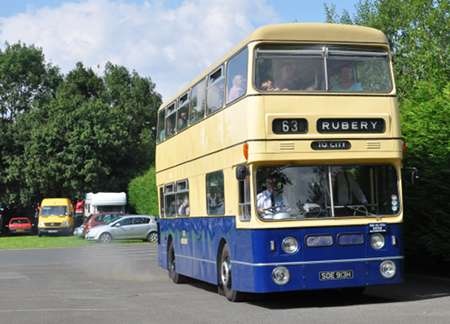
Back to the picture and here’s 3913 built in 1969, it was one of the final batch of buses ordered by Birmingham Corporation but delivered to WMPTE immediately after its formation and now preserved at Wythall Transport Museum it is a Daimler Fleetline CRG6LX with a Park Royal H47/33D body.
Ken Jones
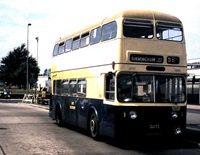 Vehicle reminder shot for this posting
Vehicle reminder shot for this posting
28/08/13 – 05:45
I seem to remember Leicester was another city that specialised in cross city routes, that were numbered differently in opposite directions according to ultimate destination. I never knew the network well, but seem to remember that Eyres Monsell in one direction, became Stocking Farm in the other, with completely different (and non-sequential) numbers.
Stephen Ford
02/09/13 – 05:54
Stephen, towards Eyres Monsell 88, towards Stocking Farm 54 BUT only if crossing the City Centre – journeys terminating in the City Centre showed the outward number. The City Centre – Eyres Monsell section (88) was joint with BMMO, but operated entirely by LCT . . . as indeed were all other "joint services", operated solely by one or the other partner. Returning to Birmingham, am I right in thinking that on the joint Dudley Road services BMMO had special "lazy displays" which showed eg. "Birmingham & Dudley"? What was BCTs practice on its share – did it persist with just showing the outward destination?
Philip Rushworth
09/10/14 – 10:02
I don’t remember this not changing destinations at all.
Perhaps it’s because I used the circular routes often instead of crossing the city and on those routes the terminus markers were much more important if one wanted to get all the way to one’s destination?
I have no idea how many routes Birmingham had back then and I was very young in 1965. My memories would be mostly of a handful of routes I used travelling cross-city to and from school in the 70s but I don’t remember ever being confused about a route or destination.
I could well imagine, however, drivers pressed for time running late, just not bothering to change the destination at the terminus.
Adrienne O’Toole
09/10/14 – 17:26
From 1956, Newcastle Transport had a trolleybus service that may have been unique in the wonderment of its route and the numbering changes along it. In one direction it was a 43 changing to 36 part way through the journey and in the other direction 44 changing to 33… It ran from Osborne Road to the Central (railway) Station and on its way passed through the city centre TWICE. The overall journey time was 53 minutes, service frequency being every ten minutes, seven days a week. Well, it was a long time ago!
Imagine a lower case letter ‘d’. Osborne Road terminus is at the top of the stem of the letter and the city centre is the lower half of the stem. Just before reaching the tail at the bottom of the stem (where the Central Station was situated) the service ran off in a long clockwise circle through the western suburbs of Elswick, Benwell, Denton and Fenham, returning to the city centre, running down the stem for the second time then terminating at the Central. The service was bidirectional and its numbering was: 43 Osborne Road to Denton Road, 36 Denton Road to Central Station in one direction and 44 Central Station to Fenham, 33 Fenham to Osborne Road in the other. The change of service number en route in each direction avoided confusion for passengers waiting in that part of Grainger Street along which each vehicle passed twice. Oddly this change of number occurred at different locations in the two directions, just over a mile apart, but it was common practice for crews to change the blinds well before these official locations, putting the separation out to nearer two miles! All this came about when the new Slatyford Lane Depot was opened and the associated new wiring along Silver Lonnen was utilised to link two existing services (the 33 and 36) into something much bigger.
Tony Fox
Quick links to the - Comments Page - Contact Page - Home Page

